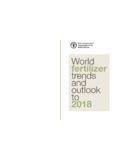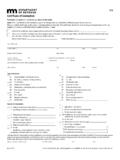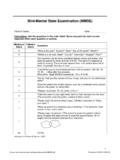Transcription of STATE OF THE WORLD’S FORESTS
1 FORESTS AND AGRICULTURE: LAND-USE CHALLENGES AND OPPORTUNITIESSTATE OF THE world S FORESTS2016 STATE OF THE world S FORESTS 2016 FAOINDONESIA. Terraced rice fields on the island of Bali. In order to make the most of the land and prevent erosion, this terracing system maintains the ecosystem while providing a livelihood for local PHOTO FAO/Adi WiratmoRecommended citation:FAO. 2016. STATE of the world s FORESTS 2016. FORESTS and agriculture: land-use challenges and opportunities. designations employed and the presentation of material in this information product do not imply the expression of any opinion whatsoever on the part of the Food and Agriculture Organization of the United Nations (FAO) concerning the legal or development status of any country, territory, city or area or of its authorities, or concerning the delimitation of its frontiers or boundaries.
2 The mention of specific companies or products of manufacturers, whether or not these have been patented, does not imply that these have been endorsed or recommended by FAO in preference to others of a similar nature that are not 978-92-5-109208-8 FAO encourages the use, reproduction and dissemination of material in this information product. Except where otherwise indicated, material may be copied, downloaded and printed for private study, research and teaching purposes, or for use in non-commercial products or services, provided that appropriate acknowledgement of FAO as the source and copyright holder is given and that FAO s endorsement of users views, products or services is not implied in any requests for translation and adaptation rights, and for resale and other commercial use rights should be made via or addressed to information products are available on the FAO website ( ) and can be purchased through FAO 2016 Food and Agriculture Organization of the United NationsRome, 20162016 STATE OF THE world S FORESTSFORESTS AND AGRICULTURE.
3 LAND-USE CHALLENGES AND OPPORTUNITIESISSN 1020-5705 CONTENTSFOREWORD viACKNOWLEDGEMENTS viiiACRONYMS AND ABBREVIATIONS ixEXECUTIVE SUMMARY xKEY MESSAGES xivCHAPTER 1 INTRODUCTION 1 CHAPTER 2 TRENDS IN LAND-USE CHANGE 7 Key messages Introduction A global history of forest conversion Twenty-first century land-use change dynamics Drivers of conversion from forest to agriculture 17 Drivers of conversion from agricultural land to forest 22 CHAPTER 3 THE GOVERNANCE AND MANAGEMENT OF LAND-USE CHANGE 25 Key messages Introduction Policies for governing land-use change between forest and agriculture Legal frameworks for land-use change from forest to agriculture: complexities and challenges Investments in agriculture and FORESTS and their impacts on land use Institutional mechanisms for governing land-use change 45 CHAPTER 4 MAKING ROOM FOR FORESTS AND FOOD SECURITY 51 Key messages Reducing deforestation and improving agriculture and food security Country case studies Common themes and lessons learned.
4 How to improve food security and increase agricultural production without reducing the forest area 79 CHAPTER 5 TOWARDS BETTER GOVERNANCE OF LAND USE FOR FORESTS AND AGRICULTURE Key conclusions Policy implications 91 ANNEXDEFINITIONS AND METHODOLOGY 95 Definitions 96 Methodology 98 REFERENCES 104| iv |The proportion of undernourished people in the total population is the indicator known as prevalence of undernourishment (PoU). See Annexes 2 and 3 of this report for further details. Ecullentem facerrum quam, quatet occus acepro modit quibus autat laut omnihitias BORIA VOLOREIUM, SIT AUT QUIS DOLORITI CONECTUS, SEQUETABLES, FIGURES & BOXES TABLES 2 .1 Countries with net gains in agricultural area and net losses in forest area, 2000 2010 Examples of coordination between sectors, as evident in sectoral policies Examples of reasons for allowing forest conversion and related conditions Comparison of country capacities for forest area change monitoring with the quality of reported data on drivers derived from the REDD+ readiness reports of 45 countries Increases in forest area and improvements in food security, 1990 2015 55A.
5 1 Number of policy documents analysed and contents of policy databases Countries used for the analyses presented in figures 103 FIGURES 2 .1 Land area by major land-use class, 2010 Net annual average change in forest and agricultural land, by climatic domain, 2000 2010 Net annual average forest area change, by climatic domain (000 ha per year) Percentage of net forest change and rural population change, by climatic domain, 2000 2010 Net annual average change in agricultural and forest area in countries grouped by income category, 2000 2010 Net annual average change in agricultural and forest area in subregions, 2000 2010 Net annual average change in agricultural and forest area in subregions, 2000 2010 Net changes in agricultural and forest area, by country/territory, 2000 2010 Estimate of (A)
6 Proportion of total area of land-use change associated with various proximate drivers of deforestation, and (B) absolute net forest area change associated with proximate drivers of deforestation, by region, 2000 2010 212 .10 Proportion of deforestation attributed to various drivers in seven South American countries, 1990 2005 Percentage of 60 national policy documents (from 27 countries) addressing land-use change between forest and agriculture, by policy type Factors contributing to forest loss, as stated (single mention) in the forest policies of seven countries exhibiting decreases in forest area and increases in agricultural area in 2000 2010 Priorities listed in 34 agriculture and forest policies in 18 countries Benefits of FORESTS , as mentioned in agriculture policies (ten countries) Strategies for food production in agriculture policies (nine countries)
7 Changes in management rights to publicly owned FORESTS , 1990 2010 Typical stages of a process for declassifying a forest area before permits for conversion may be allocated Relationship between investment in agriculture, change in forest area, and poverty Public expenditure on FORESTS , forest growth rates, and the forest sector s contribution to national gross domestic product Total private forest plantation investment in developing countries, 2 011 443 .11 Ministry with main responsibility for forest policy, 2008 44A .1 Countries classified according to dominant climatic domain 100 BOXES SDGs and targets that refer explicitly to agriculture and FORESTS Importance of law enforcement in preventing illegal forest conversion Example of legal provisions on forest conversion, and implementation challenges.
8 In Papua New Guinea Indonesia s One Map initiative Brazil s Rural Environmental Registry Key factors contributing to positive trends in food security and forest cover in Chile Key factors contributing to positive trends in food security and forest cover in Costa Rica Key factors contributing to positive trends in food security and forest cover in the Gambia Key factors contributing to positive trends in food security and forest cover in Georgia Key factors contributing to positive trends in food security and forest cover in Ghana Key factors contributing to positive trends in food security and forest cover in Tunisia Key factors contributing to positive trends in food security and forest cover in Viet Nam Integrated policy for FORESTS , food security and sustainable livelihoods lessons from the Republic of Korea 78| v |FOREWORDS tate of the world s FORESTS 2016 could not be better timed, as FAO is gearing up to fulfil its key role in helping countries develop national plans, policies and programmes to achieve the Sustainable Development Goals (SDGs).
9 The 2030 Agenda recognizes that we can no longer look at food, livelihoods and the management of natural resources separately. It calls for a coherent and integrated approach to sustainability across all agricultural sectors and food report explores the challenges and opportunities represented by the complex interrelationship between FORESTS , agriculture and sustainable development. It demonstrates that the sustainable management of both FORESTS and agriculture, and their integration in land-use plans, is essential for achieving the SDGs, ensuring food security and tackling climate know that FORESTS and trees support sustainable agriculture by, for example, stabilizing soils and climate, regulating water flows, giving shade and shelter, and providing a habitat for pollinators and the natural predators of agricultural pests.
10 When integrated judiciously into agricultural landscapes, FORESTS and trees can therefore increase agricultural productivity. FORESTS and trees also help ensure the food security of hundreds of millions of people, for whom they are important sources of food, energy and income, including in hard , agriculture is still the major driver of deforestation globally, and agricultural, forestry and land policies are often at of the world s FORESTS 2016 shows that some countries have been able to reconcile the aspirations of the different sectors, increasing the agricultural productivity and food security of their populations while also halting and even reversing deforestation. The report presents case studies for seven such countries, and others have made similar transitions. The challenge today is to encourage such positive trends in countries especially low-income countries in which food insecurity is still rife and where FORESTS are still being lost.















